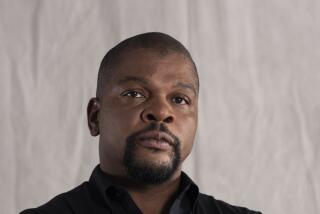ART REVIEWS : Wiley Spins Yarns With the Boys : Masculinity, a taste for puns and a penchant for storytelling mark his work, on view at L.A. Louver Gallery.
Thereâs something about the Bay Area that brings out the backwoods philosopher in people; R. Crumb, Bruce Conner and William T. Wiley all seem cut from the same cloth--theyâre all cranky, idealistic iconoclasts who express their despair over the human condition with curmudgeonly gallows humor. This aesthetic isnât exclusive to the Bay Area, however; rather itâs a manifestation of a distinctly American sensibility that stretches back to Herman Melville and can be seen today in the art of H.C. Westermann, Terry Allen, Michael McMillan and Bruce Nauman, among others.
All those great talents come to mind when perusing the exhibition of mixed media assemblages, drawings, paintings and watercolors by William T. Wiley on view at the L.A. Louver Gallery in Venice. In fact, one could almost make the case that these artists compose a school. For starters, they all make art thatâs intensely masculine without being sexual. That masculinity takes the form of boyish exuberance in work by McMillan and Westermann (William Wegman takes a similar tack in his work), while Allen and Nauman speak in the deep, gritty voices of world weary cowboys (Wiley operates somewhere between those two camps--his work is at once whimsical and grim). These artists also share a taste for puns, and an abiding affection for the tradition of oral storytelling.
Narrative is very much at the heart of things for Wiley--his work is incredibly gabby. Employing crudely lettered script (and phonetic spelling) as a kind of brush stroke, his dense, obsessively developed images are like illustrated diaries--a single piece will explode with storylines that shoot out in dozens of different directions. âAnything you look at carefully is very complex,â says Wiley, âand thereâs no surface that isnât just crawling with information.â Wiley seems to have set himself the task of encapsulating a universe âcrawling with informationâ every time he goes to bat, and each piece usually involves one or more allegorical stories that function on multiple levels.
One of the founding fathers of the Bay Area funk style, Wiley has a very loose way of working and his art kicks up a good deal of visual cacophony. He has a rather hallucinatory approach to drawing and composition which, coupled with his tendency to anthropomorphize the universe, adds up to a kind of stoned, comic book realism. Combining elements of Zen, Dada, Surrealism and American folk art, his art looks like the handiwork of a very sophisticated hippie. Heâs attracted to wildly radiant colors and much of his work is evocative of âThe Sorcererâs Apprenticeâ segment of âFantasiaâ; ideas of alchemy, childhood, loss and desire all ricochet off one another.
L.A. Louver Gallery: 77 Market St.; to April 13; (213)-822-4955. Closed Sundays and Mondays.
Exercise in Nostalgia: Landscape, that most enduring of genres, gets another go-round in the work of Bruce Everett on view at the Tortue Gallery in Santa Monica. An L.A. artists whoâs been showing hereabouts for 23 years, Everett comes to the style at a period when itâs undergoing a profound transformation. Traditionally a means for expressing faith in natureâs transcendent powers to endure and a symbol of collective cosmic health, landscape painting has taken on political content that it never had prior to the 20th Century. In a world that lurches from one ecological disaster to the next, one canât help but regard sublime landscapes of the sort Everett turns out as an exercise in nostalgia; these homages to earth and sky unstained by the hand of man are like souvenirs of the past, and seem no more real to us today than a Bruegel painting of happy peasants in a village square. Manâs done a diabolically good job of destroying nature, and on the rare occasion that he stumbles across a vast expanse of empty land, heâs pretty much forgotten how to function in it. Consequently, visual valentines of the sort Everett turns out have a peculiar hollow ring.
One gathers from literature provided by the gallery that this isnât what Everett is getting at with his work at all. Rather, he intends that his work inspire epiphanies, and heâs firmly in the tradition of Frederic Church in that he shoots for something very grand in his paintings. Photo Realism is the most modest and humble of painting philosophies in that it revolves around the artist deferring to a machine (the camera). Consequently, thereâs a vague admission of failure of imagination to Photo Realism, and the cymbals donât crash quite so loudly around a Photo Realist reading of the great outdoors. This isnât to imply that Everett is a downbeat painter; he handles light quite skillfully and his paintings give off a gorgeous, luminous shimmer. The paintings look quite lovely in fact; itâs the subtext thatâs disturbing.
Tortue Gallery: 2917 Santa Monica Blvd., Santa Monica; to April 20; (213)-828-8878. Closed Sundays and Mondays.
More to Read
The biggest entertainment stories
Get our big stories about Hollywood, film, television, music, arts, culture and more right in your inbox as soon as they publish.
You may occasionally receive promotional content from the Los Angeles Times.










